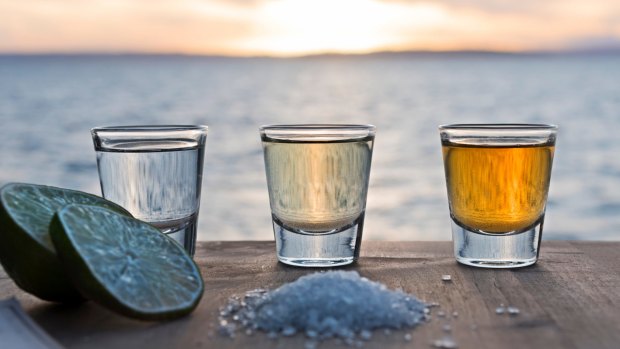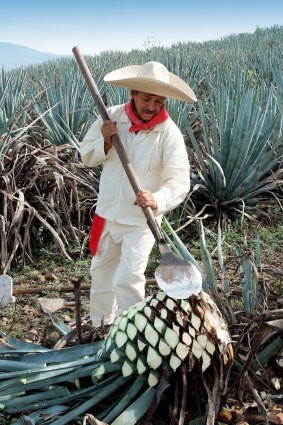By Rob McFarland

Mexicans are bemused by foreigners who choose to slam tequila rather than sip it.Credit: Richard Theis / EyeEm
Now and again you learn something that shatters a long-held cultural myth. For example, when I first moved to Australia, I was genuinely shocked to discover that almost no one drinks Foster's, a beer that in England is championed as the very definition of ocker Aussie-ness. Here in Cancun, Mexico, I've just had another misconception blown away – Mexicans don't do tequila shots. They prefer to sip and savour their most famous export, often from a brandy-style snifter glass to better appreciate its aromas and flavours.
The salt and lemon-accompanied "lick, sip and suck" evolved in the US as a way to disguise the often challenging taste of tequila blanco (un-aged white tequila). However, as I've just learnt from David, my server at La Destileria, a restaurant in Cancun that offers tequila tastings and tours, blanco is just one of several tequila varieties.
We start the tour in the restaurant's car park where he points out an example of the blue agave plant from which tequila is made. For a drink with such a messy reputation, the regulations surrounding its production are surprisingly stringent. Tequila can only be made from this one species of agave (rather than the country's 100 plus other varietals) and by law only five Mexican states are licensed to produce it.

Typical Jimador working in the field of agave industry in Tequila, Jalisco, Mexico.Credit: camaralenta
It takes generations of experience to know when the piña (the heart of the plant) is ready to be harvested. Pick it too early or too late and it won't have the right sugar content.
We head into La Destileria's small museum and David shows me an example of the traditional stone oven in which the harvested piñas are baked. After being cooked for about 72 hours, they're crushed and the sugar is extracted using steam. This "honey water" is then fermented in vats before being distilled twice to produce white tequila.
Given all that work, no wonder Mexicans are bemused by foreigners who choose to slam it rather than sip it.
In addition to tequila blanco, most tequila houses also produce aged tequila by maturing it in oak barrels. Two months to a year produces reposado (rested) tequila, one to three years creates añejo (aged) tequila, and more than three years produces extra añejo (extra aged).
We retire to a table on the restaurant's terrace and David pours me a small glass of Don Julio tequila blanco.
"What does it smell of?" he asks. "A hangover," I reply.
I take a sip and recoil at the distant memory of late-night drinking games. As a nod to foreign tourists, the tasting plate also has salt and lime, but even with those (or perhaps because of them) it still feels like a punch in the throat.
I quickly move on to the Don Julio reposado, which is served with a glass of sangrita, a spicy concoction containing orange, lime, tomato juice and Tabasco sauce. I take a sip of each and the combination tastes much like a Bloody Mary, one of my least favourite cocktails. So far, so not good.
Next is a caramel-coloured Don Julio añejo. Now we're talking. It's much smoother, with subtle hints of butterscotch and honey and a light, spicy finish.
Finally, I try two types of extra añejo. Interestingly, the most expensive – a $US399 bottle of Don Julio Real with an elaborate silver stopper – isn't my favourite. That accolade goes to the $US99 Cava de Oro, a dark sweet smoky elixir that's spent five years in charred French oak and tastes more like a brandy.
By now things are getting a little blurry so we order some starters and are soon tucking into a tasty selection of empanadas, sopes (round tortillas topped with black beans, chicken and cheese) and taquitos (fried rolled tortillas filled with chicken). For main I try chalupas – delicious fried tortillas topped with shredded pork, avocado and onion. I foolishly douse one with some innocuous-looking green salsa. Two seconds later my head explodes.
While I attempt to soothe my flaming palate, a five-piece mariachi band sidles out onto the terrace. Dressed in fetching black suits with floppy red bow ties and enormous sombreros, they stroll between tables playing a crowd-pleasing selection of Mexican tunes.
Much like the rest of Cancun, La Destileria isn't the most authentic insight into Mexican culture. It's clearly aimed at tourists, but it's fun, the food is good (just steer clear of the green salsa) and the tour and small museum do a decent job of explaining the country's most celebrated drink.
As I get up to leave, a Mexican man zigzags unsteadily past my table, shirt untucked and hair dishevelled. Clearly, not everyone follows the sip and savour rule.
Rob McFarland was a guest of Air New Zealand and Chimu Adventures.
Air New Zealand flies via Auckland to Houston. United, Spirit and Southwest fly direct from Houston to Cancun. See airnewzealand.com.au; united.com; spirit.com; southwest.com.
EAT
La Destileria is open for lunch and dinner seven days a week. Tequila tour and tasting available 1pm to 5pm. Cost from 256 pesos. Tequila tasting available any time. Cost from 180 pesos. Boulevard Kukulcan km 12.65, Zona Hotelera, Cancun. Phone +52 998 885 1086, see ladestileria.com.mx.
TOUR
Latin America specialist Chimu Adventures can create a tailor-made Mexico itinerary including flights, accommodation, transfers and tours. Phone 1300 773 231; see chimuadventures.com.
Sign up for the Traveller Deals newsletter
Get exclusive travel deals delivered straight to your inbox. Sign up now.